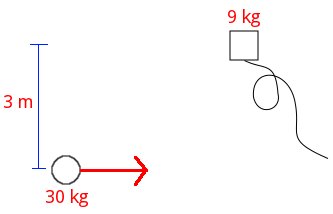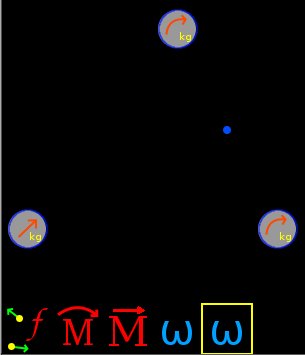Next: Example 10, Previous: Example 8, Up: Examples circular dynamics of particles [Contents][Index]
13.9 Example 9
A child of 30 kg is playing on an ice rink. The child moves at a linear speed of 5 m/s when passing beside a box of 9 kg, which has a rope tied. If the child takes the rope, and once stretched the separation between the child and the box is 6.5 meters, describe the subsequent move of child-box system.

Solution with FisicaLab
Select the Dynamics group and, inside this, the Circular module. Erase the content of the chalkboard and select the SI system. And add one element Mobile with linear movement, two elements Mobile with circular movement, one element Center of rotation, one element Final system, two elements Angular velocity, one element Angular momentum and one element Linear momentum. As show the image below:

The element Mobile with linear movement represents the child in the initial state. Assuming initially that moves along the X axis, we have:
- Name
initialChild
- m
30
- v
5
- x
0
- y
0
- ang
0
- a
0
Now the element Center of rotation represents the center around which the child and the box tour at the final state. Noting that the angle of inclination of the rope, once taut, with respect to the horizontal is 27.486 degrees, and the distance from the center of rotation to child is 1.5 meters, we can obtain the coordinates of the center of rotation as (these operations can be done directly at text fields):
x = 1.5*cos(27.486) = 1.331 y = 1.5*sin(27.486) = 0.692
Thus we have for this element:
- Name
center
- v
vCenter
- ang
angCenter
- x
1.331
- y
0.692
Now the element Mobile with circular movement at top, represents the box, and calculating the distance from this to the center of rotation (5 m, the function rd() can be used to get this value), we have:
- Name
finalBox
- m
9
- vt
vtBox
- r
5
- y
0
The other element Mobile with circular movement to the lower right side, represents the child in the final state, and calculating the distance of the center of rotation (1.5 m, the function rd() can be used to get this value), we have:
- Name
finalBoy
- m
30
- vt
vtBoy
- r
1.5
- y
0
The box and the child have the same angular velocity. Therefore for the Angular velocity elements, respectively:
- Object
finalBoy
- vang
vang
- Object
finalBox
- vang
vang
The element Center of rotation and the two elements Mobile with circular movement are the final state. Then we add them to the element Final system, which we call final:
- Name
final
- Object 1
center
- Object 2
finalBoy
- Object 3
finalBox
- Object 4
0
To the element Angular momentum, taking into account that no external moments applied:
- System i
initialBoy
- System f
final
- M
0
And to element Linear momentum, no external forces are applied, we have:
- System i
initialBoy
- System f
final
- Fx
0
- Fy
0
Now click in the icon Solve to get the answer:
vang = 0.355 rad/s ; vCenter = 3.846 m/s ; angCenter = 360.000 degrees ; vtBox = 1.774 m/s ; vtBoy = 0.532 m/s ; Status = success.
The center of rotation moves horizontally to the right with a speed of 3.846 m/s. And the boy and the box rotate in a counter-clockwise with an angular velocity of 0.355 rad/s.
Note: Note that in this problem the mass of 9 kg does not appear in the initial state. This is because for these problems FisicaLab allows only one object in the initial state. The object that initially is moving.